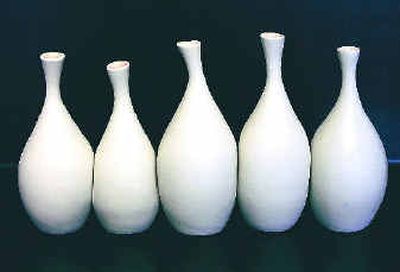Summer of ceramics

It’s going to be an extraordinary summer of ceramics.
Between now and the end of August, a dozen exhibitions will present a range of contemporary ceramics not before seen in the Inland Northwest.
“Spokane Celebrates Ceramics” represents a Herculean community effort coordinated by Jim Kolva, Lisa Nappa and Jochen Wierich.
“It’s been a great collaboration among galleries, universities, individuals and businesses,” said Nappa, assistant art professor at Eastern Washington University. “Over the next couple of months people will be able to see some of the finest examples of ceramics in the United States.”
Venues include Gonzaga University’s Jundt Arcade Gallery; Kolva-Sullivan Gallery; Red Sky Gallery; Spokane Art School; Lorinda Knight Gallery; Art By Yourself and Spike Coffee House; Gallery at Joel; Spokane International Airport; and the Art Spirit Gallery in Coeur d’Alene. (See schedule on this page for details.)
At the epicenter is of the celebration is “A Ceramic Continuum: Fifty Years of the Archie Bray Influence,” opening Friday at the Northwest Museum of Arts and Culture.
The 85 objects in the show were selected from the Archie Bray Foundation for the Ceramic Arts’ permanent collection and mirror the evolution of contemporary ceramics in the United States.
Nestled in the foothills of the Rocky Mountains west of Helena, the Bray has long had a reputation for attracting the world’s leading ceramists as resident artists. Since the early 1950s, top ceramic artists have been making the pilgrimage to Montana.
“This place is unique,” said resident director John DeWeese. “It is the only place like it in the world where ceramic artists can come for an extended period of time and concentrate on their individual work.”
In 1951, Western Clay Manufacturing Co. owner Archie Bray opened a pottery near his brickyard as a place for serious ceramic artists to nurture creative exploration.
World-renowned Montana natives Rudy Autio and Peter Voulkos, then graduate students, were the first resident artists. Since then 300 more artists have followed, including James and Nan McKinnell, Ken Ferguson, Hun Chung Lee, Lucy Breslin, Jeanne Quinn, Kurt Weiser and Doug Jeck.
Each year the Bray selects up to 20 artists from throughout the United States, Europe and Asia to live and work in Helena. This year residents will come from the United Kingdom, Japan, Israel and 13 states.
“There is a special energy at the Bray that develops when a group of artists come together in a nurturing environment,” said Kolva, an Archie Bray board member and Spokane art collector. “They are all stretching themselves individually while sharing ideas and techniques with each other.”
That spirit is reflected in the MAC exhibition.
“The range of work is just phenomenal,” said Jochen Wierich, museum curator of art. “Each is a very unique piece.”
The traveling exhibit was organized in 2001 by Peter Held, then the director of the Holter Museum of Art in Helena.
“Since the focus was the 50-year celebration, I wanted to paint the best picture that covered the span of ceramic activity at the Bray from 1951,” Held said from his office at the Arizona State University Art Museum, where he is curator of ceramics with the Ceramic Research Center.
“First and foremost I selected objects for the quality of the work,” he said. “Then I wanted a spread of objects that covered all eras, with a balance of functional ceramics, decorative vessels and sculpture.”
In the show are three pieces by Autio, including “Woodstack,” a large, expressive sculptural piece decorated with images of female forms and horses.
“Rudy was never a functional potter,” said Held. “He always stayed within a vessel tradition, but he used it to express his more painterly concerns. His nickname is the ‘Matisse of American Ceramics’ because of his vibrant colors and frolicking naked women.”
Also in the show are vessels by Voulkos.
“Peter was an exceptional functional potter,” said Held. Voulkos had won a national ceramics competition before he was out of undergraduate school and has been credited with moving pottery from crafts to fine art.
“Studio ceramics was in its infancy back then,” said Held, “and having those two rising stars as the first artists, the Bray was able to attract a strong cadre of their peers to come and work.”
For more than half a century, he said, “It’s been the backbone of contemporary ceramic arts in the United States.”